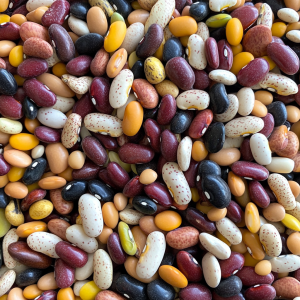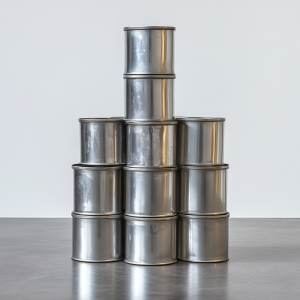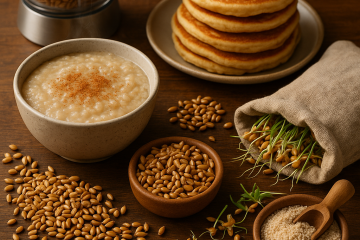
Dried beans have a 25-30 year shelf life when stored properly
I got into some dialogue over the past day or so about always rotating the foods in our pantry, but I did want to point out that there is an exception to this guideline. So here it goes:
Food Storage: More Than Just Beans and Bunkers!
Ever heard the phrase “food storage” and pictured mountains of canned beans in a doomsday bunker? Most of my readers know that I’m not fond of that term altogether because it usually means someone’s just socking food away and forgetting it, and it’s typically not food that they are familiar with and love. Well, there is a time when “food storage” is acceptable. And we’ll get into that today. So welcome to the world of smart food storage, where your pantry isn’t just a dusty museum of forgotten cans but a thriving ecosystem of deliciousness waiting to be devoured.
The Golden Rule: Eat What You Store, Store What You Eat
This should be familiar to many, and we kick things off with the golden rule of food storage: buy what you eat, and eat what you buy. It’s not rocket science, folks! If pasta is your jam, then, by all means, create a carb paradise in your pantry. But remember, the goal is to turn your storage space into your personal grocery store. Shop from it first, replace what you use, and voila! You’re always eating fresh food that tickles your taste buds, and your wallet will thank you, too. I’d also advise you to have your shopping days driven by sales and deals that you can find.
The Rotation Station: Keep It Fresh, Keep It Moving
Now, let’s talk about the secret sauce of a well-managed pantry: rotation. Think of your pantry as a delicious conveyor belt. Use the oldest stuff first and keep replenishing with the freshest at the back. It’s not just about playing Tetris with your cans; it’s about avoiding waste, saving money, and ensuring your food is always ready for its taste bud tango.
Another important point: Let’s debunk a myth: those expiration dates? They’re more like suggestions from overzealous marketers than actual food science (except for baby formula – that’s the real deal). So don’t toss that can just because the calendar says so. Use your senses instead!
Storage Conditions: Cool, Dry, and Dark – The Holy Trinity
When it comes to storage conditions, think of cool, dry, and dark as the holy trinity of food preservation. The right environment can turn your average Joe can of beans into a time-traveling taste sensation. So, no storing that fruit cocktail next to your stovetop or in the sauna-like garage, capisce?
Airtight Containers: Seal the Deal

Honey has indefinite shelf life. It’s practically immortal.
Now, let’s get serious about sealing. Not all containers are created equal, my friends. Your run-of-the-mill plastic tubs might be fine for short-term storage, but for the long haul? But they are not impervious to oxygen and moisture. Instead, you need the heavy hitters. We’re talking food-grade Mylar bags with oxygen absorbers, vacuum-sealed bags, or even glass jars with tight-sealing lids. And let’s not forget the mighty #10 can – the superhero of long-term food storage!
The Long-Term Stash: Your Edible Insurance Policy
Here’s where we flip the script on our “rotate, rotate, rotate” mantra. If you’ve got the means to stockpile food as a long-term backup (think of it as your “just in case” culinary insurance policy), then go for it! But here’s the catch: this strategy only makes sense when you’ve got enough to cover your daily needs for a year. It’s like having a homeowner’s insurance policy that you hope you’ll never need to use, but you’re darn glad it’s there if you do.
The MVPs of Long-Term Storage
So, what should you store in your long-term stash? There are some foods that are better than others. Here’s your guide to the foods that laugh in the face of time:
- Grains (Wheat, Rice, Rolled (not quick) Oats): When stored in airtight containers, these can last up to 30 years! Pro tip: Add food-grade diatomaceous earth (2 heaping tablespoons per 5 gallons) to your grain containers. It’s not just for pest control; it’s actually good for you!
- Honey: The immortal condiment. It might crystallize, but a warm bath will bring it back to life.
- Soy Sauce: Your future stir-fries are safe for about 20 years.
- Powdered Milk: Good for 20+ years when properly sealed.
- Canned Goods: These troopers can last 5-10 years or more.
- Dry Beans and Lentils: Up to 30 years of potential chili ingredients! However, the older they are, the more you’ll have to cook them. Add a bit of baking soda, and you’re golden, though.
- Freeze-Dried Foods: With proper storage, these can last up to 25-30 years.
- Salt and Sugar: Basically immortal. Just keep them dry.
- Peanut Butter: Contrary to popular belief, this stuff can last way longer than 1-2 years. We’re talking up to 10 years if stored properly if you’re not using the freshly ground versions!
- Bouillon and Soup Mixes: These flavor bombs can last up to 20 years in airtight containers.

#10 cans are great for long term food preservation
The Nutrient Game: Dehydrated vs. Freeze-Dried
Let’s talk nutrients, shall we? Dehydrated foods, while great for storage, can lose some of their nutritional mojo. Vitamins A and C are the prima donnas here, often taking a bow during the dehydration process. But fear not! Most minerals and fiber stick around for the long haul.
Freeze-dried foods, on the other hand, are the nutritional overachievers. This process preserves most nutrients, including those finicky vitamins. You’re essentially locking in the goodness at its peak. It’s like hitting the pause button on freshness!
Remember, whether you’re rotating through your pantry like a pro or setting aside a stash for the long term, the goal is to make your food storage work for you. It’s about smart planning, not hoarding. So go forth and store wisely, my friends.

